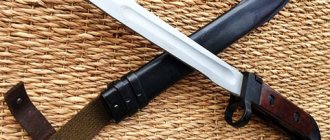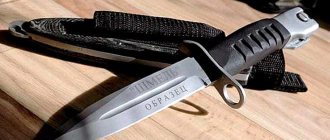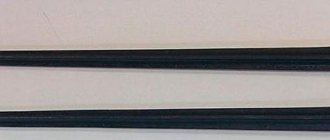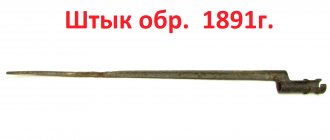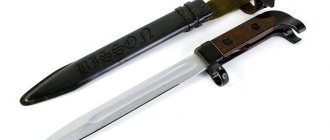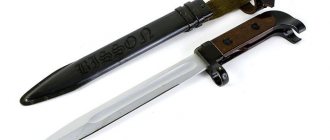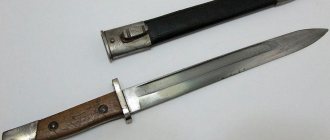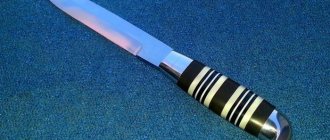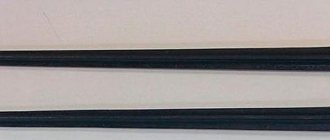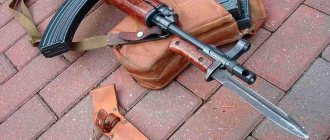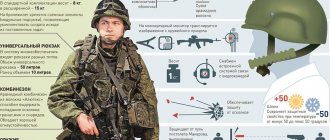A knife is one of the most important elements in a fighter’s equipment. Nowadays, with the intensive modernization of various models of firearms, piercing and cutting products play a small role in combat conditions.
Nevertheless, for fighters operating in difficult climatic conditions, a knife is considered an indispensable tool. Such universal tools are called “survival knives.” Today, such blades are presented on the market in a wide range. Among them, the combat knife “Bumblebee” occupies a special place.
This blade is in service with the Russian army. The description of the “Bumblebee” knife is presented in the article.
Story
For the first time, rifles began to be equipped with bayonets in the 17th century in France. This practice greatly facilitated the task of the French soldiers, since it was difficult to use firearms in close combat. Later, in the process of designing American bayonet knives, the developers took into account the experience of the Vietnam War. The low effectiveness of standard weapons was also felt by Soviet soldiers in Afghanistan. The urgent need for a piercing and cutting product suitable for use in difficult climatic zones served as the impetus for the development and creation of reliable and multifunctional combat blades. The product is listed as the NB-2 “Bumblebee” knife.
Weapon Features
The Bumblebee knife is an army tool necessary as a weapon and for survival. Its purpose:
- in close combat;
- to eliminate fighting dogs;
- to defeat enemy weapons by throwing or cutting;
- for escorting enemy prisoners.
This good knife has design features that provide it with a high degree of reliability and durability.
The “Bumblebee” knife consists of:
- from a blade;
- guards;
- handles
About the manufacturer
Serial production of Shmel knives is carried out by KAMPO JSC, a leading Russian enterprise in the manufacture of breathing systems used in aviation, astronautics, emergency medicine, diving and fire fighting. According to experts, at first, many were surprised by the fact that an enterprise specializing in respiratory systems began producing knives. However, the decision of the company’s specialists to engage in the production of piercing and cutting products is quite logical. Since a knife is an integral tool for a diver, the manufacturer of diving equipment has mastered the production of special blades for use in difficult natural conditions, including underwater. By order of the Russian Ministry of Defense, this enterprise produced several tens of thousands of piercing and cutting products. Work on creating the “Bumblebee” knives was carried out as part of the “Ratnik” project.
About creation
In 2010, in the city of Vorsma, in accordance with the terms of the project, a bayonet-knife was presented, which had the same name “Bumblebee”. According to the terms of the competition, the piercing and cutting product was equipped with an asymmetrical two-edged blade capable of piercing a 6B23 body armor vest to a depth of 200 mm with a force of 40 J. In addition, the combat knife had to be equipped with special nippers and a sharpening stone. However, the characteristics of the “Bumblebee” knife from “CAPO” did not satisfy the customer. Four more manufacturers, whose names were not mentioned anywhere, also presented their samples of special knives. Of all the options presented, members of the commission of the Russian Ministry of Defense were interested in products from KAMPO JSC.
The bayonet-knife of this manufacturer has shown great effectiveness when delivering deep piercing blows. The highly sharpened blade easily penetrates the flesh. According to experts, this does not exclude the risk that the blade may get stuck in the tendons, which is due to the high force of the blow with the knife, which is attached to the firearm. If sharpened poorly, there was a possibility that the blade would have low penetrating properties. When designing a combat knife, the designers of KAMPO JSC had to take these nuances into account.
What is a bayonet?
A bayonet is a weapon that can be used in two ways: as a regular cutting tool or attached to the barrel of a rifle or shotgun and used in battle.
The bayonet-knife delivers deep piercing blows and can get stuck in the tendons. This impact force is explained by the fact that the blade attached to the weapon has a more powerful impact force, because the blow is delivered with both hands. If the blade is well sharpened, it will easily enter the target. Therefore, it is not made too spicy. However, the blunt edge for the knife is a disadvantage. Therefore, the superior characteristics of the bayonet as a tool reduce its combat qualities, and vice versa. When developing a weapon, designers take these features into account.
The equipment of a Russian warrior includes two knives: a multifunctional one and a combat one. The second is sometimes replaced with a bayonet-knife. All tools are highly durable. Since 1993, they have been produced by the KAMPO enterprise, which specializes in the production of military, diving, and rescue equipment. Many years of experience in production and design allowed the company to participate in a project to prepare equipment for the Russian military.
About the blade
Russian knives are distinguished by high corrosion resistance. Since in sea water, as in any chloride-containing environment, blades are susceptible to rusting and oxidation, the manufacturer uses high-alloy steel as the material for the bayonet knife. Its hardness rating on the Rockwell scale is 55-58 units.
The blade is flexible and resilient. The product is subjected to a matting procedure, due to which the presence of glare on the surface of the knife is completely eliminated. The use of anti-reflective coating is one of the important requirements for military edged weapons. The blade of the bayonet knife has a diamond shape. The product is provided with one-and-a-half sharpening. The blade does not have shock teeth or a hole for cutters. In an effort to reduce the weight of the knife, the designers equipped the blade with a longitudinal recess. According to experts, in order to prevent this bladed weapon from entering the victim’s body too deeply, and also to avoid injuring the owner in case of careless handling, the “Bumblebee” is not made too sharp.
What does the Bumblebee knife look like?
The classic bayonet is used in two ways: as a regular cutting tool or as a weapon for close combat.
It is known that the knife bayonet is designed to cause deep wounds and also get stuck inside the tendons of a person. Such power is due to the fastening, the blade was originally attached to the weapon. The soldier held onto the wooden handle and plunged the bayonet as deep as possible.
When the blade was sharpened well, it had an edge that entered the target. But a dull knife edge is a bad characteristic. This criterion significantly reduces the combat qualities of the bayonet, so we can say that the combat qualities of the weapon initially depend on several conditions. The equipment of a Russian warrior includes 2 knives: multifunctional and combat. Since 1993, modern bayonets have been produced by the KAMPO company.
Features of the blade
The Bumblebee blade is made of high quality steel. It is not subject to corrosion and is resistant to changes in climatic conditions. In addition, the steel is specially prepared to make it flexible. Flexibility is measured in advance using a special scale. The blade should spring slightly, but at the same time remain hard and stable.
The surface of the blade is specially matted, this eliminates glare. The shape of the blade is made in the form of a diamond, leaving a sharpening. The blade should not be made too sharp; it should not cause harm if handled carelessly. The task is to hit the enemy in close combat.
Garda
The knife has a guard; it is made of high strength steel. A guard is a crossbar that separates two parts: the blade and the handle. The guard prevents slipping when striking. The part consists of several parts:
- the upper part is bent towards the butt, this allows the thumb to rest;
- the lower part is made in the shape of a semicircle - this allows you to insert the bayonet into the barrel.
Handle
The shape of the handle is one of the advantages. It is made of high-strength rubber with a rough surface. The roughness makes the position of the bayonet in the palm especially comfortable. Rubber is also responsible for physical characteristics. Such a handle is not afraid of dirt, slush or the impact of additional difficulties. The handle is usually black. The surface is additionally filled with porous material.
Sheath
The blade is well protected with a steel sheath. The sheath allows you to carry your weapon safely. The surface of the sheath is traditionally coated with a black polymer. The color of the shade completely matches the shade of the handle.
About the guard
The bayonet knife is equipped with a guard, the manufacture of which uses high-strength steel. The guard is a special crossbar that separates the blade and the handle. The purpose of this device is to prevent the hand from sliding off the handle at the moment of impact. The guard of the "Bumblebee" combat knife has a special design:
- The manufacturer bent the upper part of the crossbar towards the butt, due to which the fighter can hook the knife to the belt. In addition, when holding the blade, a thumb rest is used.
- The lower part of the guard has the shape of a ring. This design feature allows the knife to be mounted on the barrel of a firearm.
About the handle
According to experts, a good combat knife should have a comfortable and ergonomic handle. KAMPO JSC uses high-strength and oil- and petrol-resistant rubber for its production. The surface of the bayonet-knife handle is rough, due to which the “Bumblebee” lies comfortably in the palm. In addition, the handle is equipped with six additional grooves. Judging by numerous reviews, this bladed weapon is not afraid of dirt, dampness and other aggressive influences. The handle of the “Bumblebee” has a noble black color. It is rounded at the end. Its design includes a special groove and a spring latch, with the help of which the knife is attached to small arms.
About purpose
The Bumblebee bayonet is a bladed weapon. In accordance with the law, its carrying and use by civilians is prohibited. Nowadays, the Russian army uses the new “Ratnik” combat equipment, which, along with means of protection, communications, reconnaissance and energy supply, also includes firearms and bladed weapons.
The task of these weapons is to cause maximum damage to the enemy in the event of an armed confrontation. The Bumblebee bayonet is used in close combat. The product is also suitable for throwing. In addition, these blades are used during the convoy of prisoners of war and to disable enemy weapons.
Combat knives: weapon or tool
In January 2013, at the age of 57, the famous designer of bladed weapons and one of our oldest authors, Igor Skrylev, suddenly died. Today we bring to the attention of our readers the latest article that Igor Aleksandrovich prepared for the magazine “Weapon”. It is dedicated to modern combat knives.
One of the important elements of a modern soldier’s combat equipment is a knife. And although now its role in battle is small, in the era of local wars it acquired a new function - it became a universal survival tool for fighters of small maneuverable groups operating in isolation from supply bases in difficult climatic conditions.
Even during the Vietnam War, American troops unexpectedly found out that their equipment, firearms and even knives were poorly suited to local conditions. The Soviet army faced a similar problem during the war in Afghanistan. The role of the main combat knife in it was performed by a bayonet-knife, the design of which turned out to be unsuccessful. Generally speaking, attempts to create universal weapons are rarely successful. A knife and a bayonet have different tasks, and different design approaches are needed to solve them.
The bayonet is attached to the weapon. In this case, the blow is delivered with both hands, both the body weight of the fighter and the weight of the weapon itself are involved. With such a blow, the blade penetrates deeply into the target; if it is well sharpened, then in addition to damaging the cutting edge in contact with bones, it can also get stuck in the tendons. Therefore, no matter how strange it may seem, the bayonet should not be too sharp. An example of a successful design is the bayonet for the SKS carbine. But for a knife, a dull cutting edge is a serious drawback. The desire to turn a bayonet into a universal tool reduces its reliability and reduces the combat characteristics of the weapon. The closer the knife is to the tool, the less suitable it is for combat, and vice versa. Therefore, when developing a new combat knife, it is always important to understand which qualities are preferable.
The development of the ideology of the combat knife as a universal tool led to a fascination with survival knives.
In particular, the “Basurmanin” knife has been adopted by the Russian army. This is a hybrid of the King of the Jungle-2 knife and the HP-2 knife. "Elf" is another design used by GRU special forces. Both samples are similar, but the first is more of a tool knife, and the second is closer to a combat knife. Despite the fact that "Busurmanin" and "Elf" have been adopted, they are used in small quantities. Thus, “Basurmanin” turned out to be bulky, heavy and expensive, and they began to produce a commercial model based on it. Now it is supplied as a survival knife to border guards who serve in regions with difficult climatic conditions. But even in such sophisticated models it is not possible to completely combine the functions of a weapon and a tool. The easiest way is to separate these functions. And use a combat knife in combination with a small multifunctional knife. The latter is usually foldable. An example is the famous Swiss army knives.
Another approach is also possible. The Polish army developed an interesting folding knife, which is still used in special forces. Its blade has dimensions sufficient for combat use, and in addition, the knife has high instrumental richness. It came out quite powerful, and for this we had to pay with a lot of weight. The Poles themselves call it the first “tool”, which appeared much earlier than Lazerman’s developments. However, he did not have pliers, so this is a rather controversial issue.
Survival knife NV-1 (knife “Basurmanin”) - adopted by the army under the designation 6X6
NR-2 - military reconnaissance knife. Nearby is a pencil case made from a handle
Survival knife "King of the Jungle" made in Spain
The Elf knife was developed at TsNIITOCHMASH for GRU special forces
The appearance of tools largely solved the problem of an auxiliary knife, but civilian models lacked strength and combat capabilities. Special army versions began to appear; they differed from civilian ones in their black coating and the presence of a crimp for detonators. Their advantage is light weight, small dimensions and not too high a price, because the base is a serial civilian model. In Russia, military versions of similar instruments with developed combat capabilities also began to appear, because no one has canceled this use of the product. And this immediately imposes restrictions on the dimensions of the blade. It cannot be less than 90 mm, but it is better if it is more than 100 mm, with a solid width and thickness. But for the classic Laserman scheme, a blade of this length is not suitable. Attempts to make an army tool with the required blade dimensions were made at TsNIITOCHMASH. They developed the KRAG tool, but it turned out to be too large and heavy. The model was never further developed.
By order of the FSB, she developed the Vzmakh-3 sapper combat knife, which was officially adopted for service. This tool is made according to a completely different design, which made it possible to increase the length of the blade to 110 mm, with a thickness of 4 mm. The knife was tested for combat use and was found suitable. “Vzmakh-3” underwent its baptism of fire even before it was officially put into service. The prototype was used in the liquidation of Chechen terrorists in Nord Ost. This product is also used by other law enforcement agencies, for example the Federal Security Service. “Vzmakh-3” is an optimal tool in terms of its parameters for use as a combat urban knife. Another area of its application is a survival knife. But for military use it is too expensive and complicated.
made an attempt to create an army version of the Varan sapper tool. But the resulting sample does not completely satisfy the military - the length of the blade is too small for combat use. The desire of the developer to create a reliable, strong tool led to the fact that the knife has large dimensions and excessive weight. And the quality of execution leaves much to be desired.
The universal combat knife of the sapper “Vzmakh-3” (below) and the mini-tool “Biker”, developed by .
Mini-tool "Biker-2" - modernized "Biker"
Already mentioned, on its own initiative, it developed a “Biker” mini-tool for civilian use. This lightweight (90 g), very flat (8 mm) tool can be placed on the sheath of the main combat knife (some Western companies do this, offering the consumer a set of a combat knife and a knife-tool). The military version of the "Biker" is equipped with a crimp for detonators. But it is not suitable for the role of a knife for serious work - it is small in size. The military needs something like a smaller and simplified version of Vzmakh-3. Therefore, for a promising set of combat equipment, technical specifications were issued for the development of both a combat knife and a folding knife-tool. In fact, the military themselves do not seem to know what they want. Thus, “Vzmakh-3” does not satisfy them in terms of dimensions and weight, but the terms of reference for the new instrument contain figures that almost coincide with its parameters. Of course, one cannot but agree that the dimensions and weight need to be reduced, but within reasonable limits. For a combat knife, the main criteria have always been strength and reliability.
But let's return to the bayonet. According to GRAU, in modern combat the use of a bayonet is so limited that it can be neglected; you just need a good knife. The length of its blade was determined to be 170 mm, which is quite a lot, although it corresponds to the parameters of combat knives in Western countries. For example, the blade of the American Marines' Ka-bar knife has this length. Some other parameters were also set to limit developers. In the technical specifications, for example, there were two small points that reduced the idea of a simple army knife to nothing - the placement of wire cutters on the sheath and the possibility of attaching to a machine gun,
independently or via an adapter. These requirements automatically complicate the design of the knife. However, there are several options to solve the problem. The simplest thing is to follow the design path of a conventional bayonet, making the blade, as indicated in the technical specifications, a dagger type with a one-and-a-half sharpening. Install a ring on the guard for putting on the barrel of the machine gun, and a release button on the handle. The result is the same bayonet-knife, the only difference is the placement of the cutters on the sheath. This is exactly the traditional path that some companies took, for example, which released the “Bumblebee” bayonet, which is very reminiscent of the existing bayonet for the AK74 assault rifle.
Bayonet "Bumblebee"
Another way is to simplify the design by using a sheath. After all, placing the cutters on the sheath turns them into a product that is almost equivalent in complexity to the knife itself. This problem can be solved in different ways. The simplest method is a removable lever, which was used on Todorov’s knife, which became the founder of bayonet knives for Kalashnikov assault rifles. It allows you to get the simplest product. The sheath for such a knife can be made of textile materials such as cordura, and the lever can be placed on the sheath in a special pocket. In this case, it is necessary to make a hole on the knife blade for docking with the lever. And it weakens the blade. In addition, using the lever is not very convenient. It is no coincidence that on bayonet-knives for the Kalashnikov assault rifle, the lever was simply combined with the sheath. This is also not the most correct way, since moving the cutters to the front of the sheath increases the size of the entire product. There is, of course, an interesting solution - move the cutters up, where they can be placed more compactly. But this scheme also has its drawbacks, the most important of which is the need to fix the cutters in the hole of the blade. Doing this in, for example, low light conditions is problematic. The easiest way to attach the machine to the machine is to use an adapter. This will simplify the knife itself, since attaching it to an adapter will not create problems associated with the dimensions of the machine itself. For example, the mount on the barrel already affects the dimensions of the guard on which the ring must be placed. This size cannot be reduced, but it goes beyond the parameters specified in the technical specifications. Therefore, the presence of an adapter is preferable to placing fastening elements on the knife itself. In addition, not every knife needs such an adapter, because its use is very limited.
Army bayonet from AK 74 assault rifle
Combat army knife FOR 2010. The inner part of the sheath is made of stainless steel, with wire cutters placed on them. There is a flathead screwdriver on the pliers
center]Sea Devil combat swimmer knife and HP-2 reconnaissance army knife[/center]
The “Splinter” universal tool is located in a pocket on the knife sheath. The insert is fixed to the scabbard using a protrusion that fits into the hole
After analyzing all these options, I came to the conclusion that the design of a modern combat knife should look different. The blade can be shortened to 160 mm without any problems. This will reduce weight, increase maneuverability and have virtually no effect on either combat or performance characteristics. They can even be increased by increasing the thickness of the blade. One-and-a-half sharpening. Differentiated lower edge for cutting, upper edge for chopping. The front part of the blade is reinforced; for this purpose, the upper edge is sharpened in the tanto style. The blade is made of steel 95X18, hardness 56-58 units. The blade has been treated with anti-reflective glass beads, which not only reduces shine, but also strengthens the outer surface of the metal due to hardening. There is also a disadvantage to such processing, although it is determined by the customer. The operation reduces corrosion resistance, even when using corrosion-resistant steels. Therefore, it is much more practical to use such a treatment in combination with a durable anti-reflective coating - titanium carbide or silicon carbide. The guard is made of the same steel, but its hardness is 45-48 units, which gives the guard good mechanical properties. This is important, since the guard is subject to large mechanical loads during operation, for example when throwing. The knife handle is made of textolite, a durable and resistant material. There is also an option made from elastron rubber plastic. The choice of handle material makes it possible to use the knife in a variety of climatic and geographical conditions. The handle has two types of corrugation. The transverse grooves in the front of the handle provide a thumb rest, which allows for good control of the knife. Next are longitudinal grooves that serve to remove moisture if the hand is sweaty or wet. The shape of the handle is not symmetrical, it allows you to understand by touch which side the knife is held. There is a metal pommel on the handle. It can play the role of a hammer, serve to deliver shocking blows and is used as a second fastening element. There is a groove into which a rubber ring fits. This mount is usually used for underwater knives, where the reliability of holding the blade in the sheath is of particular importance. The sheath is made of two parts. The internal part on which the cutters are located is made of stainless steel. The lever of the pliers is located on it. Their design is largely borrowed from the cutters of the “Sea Devil” combat swimmers’ knife, developed by. There is a flathead screwdriver on the scabbard liner cutters. The sheath has plastic inserts that protect the blade from dulling when removed. This is an important issue. For example, in the NR-2 knife there is a metal insert in a plastic sheath, which is located so that it interacts with the cutting edge of the blade. It is enough to take it out of the sheath a couple of times, and not a trace remains of sharpening. In the new knife, this drawback has been eliminated. The elasticity of the steel sheath is also used to secure the blade itself in it. To carry the knife and place it on the equipment, there is a case made of durable camouflage fabric with a soft padding that prevents the appearance of unmasking noise. The case has a pocket for the “Splinter” universal tool and a sharpening stone. The belt loops on the case allow you to attach it to various pieces of equipment. The loop for attaching to a belt is detachable. The insert is fixed to the cover using a protrusion that fits into the hole in the slip pocket. This fixation is simple and reliable. The knife received the name NA 2010 (military knife of the 2010 model).
Tool "Explosive Technique" in folded state. On the right you can clearly see the crimp for the detonators
Vzryvotekhnik has a decent set of tools
The Explosive Engineering kit also includes a universal working knife with the same name.
It is impossible not to talk about how the development of a knife-tool for the Russian army was organized. This procedure was quite unusual. The GRAU convened a meeting of bladed weapon manufacturers, issued technical specifications and a month for the development and production of samples. The R&D stage was simply assigned to the shoulders of manufacturers. It is not surprising that only three companies presented real samples. They went to the test. If for an army knife the problem of ultra-fast development could be solved (with preliminary developments, for example, I simply remade my “Maple” knife to meet new conditions), although all the samples appeared at the very last moment, then with a tool knife it turned out to be more difficult. The only contenders - the Vzmakh-3 and Varan knives - did not satisfy the military in terms of their parameters; they needed something in between these samples. There was a finished model, but its customer was one of the special services. The product received the characteristic name “Vzryvotekhnik”. Outwardly, it is similar to Lazerman’s products, but only at first glance. This product is a “changeover”.
The biggest problem with conventional sapper tools is that the presence of a crimp for detonators reduces the performance of the pliers themselves and their strength. In Vzryvotekhnika this problem is solved. Thus, the crimp of the folded “tula” is located on the pliers on the reverse side. This part of the tool is quite massive and can be used as a hammer. It also has a carbide protrusion for breaking glass, which can also serve as a glass cutter. When you turn the handles over, the pliers themselves “appear.” They are of a normal design, but have replaceable cutting edges on the cutters. This is a plus, since the pliers themselves can be made more durable and repairable. If the nippers are part of the pliers, then they must be heated to high hardness, and this may affect their strength. If there are replaceable cutting elements, the problem is eliminated. The pliers are heated to a hardness that gives optimal strength, and the cutting inserts (of much greater hardness) are simply replaced if they break. One of the tool handles has a high-strength blade; its length is 85 mm and its thickness is 4 mm. You can open it with one hand using the protruding peg. The blade in the open position rests on a rigid latch. A universal holder is located nearby. You can attach a replacement saw from an electric jigsaw to it, which expands the capabilities of the tool, since the saws can be very different. A file damaged during operation is simply replaced with a new one. A special blade for fine work can also be installed in the holder. It is made in two versions - with regular and serrated sharpening.
Special tools include a light alloy pin for making holes in explosive packages when installing detonators. The other tool set is quite common: an awl, a can opener, a file, and scissors. The scissors are made quite large and do not have a spring, which, as a rule, becomes an element of unreliability. It is replaced by a handle with a slot that allows you to open them and control them while working (like regular scissors). There is a holder for replacement bits, it can be equipped with an extension cord. The presence of replaceable bits increases the possibilities of using the tool, since you do not need to have a whole set of different screwdrivers and special socket wrenches.
Unfortunately, despite all the advantages, such a tool is not suitable for military use. It should be much simpler, more efficient and not have replaceable parts that can be lost (one of the requirements that is always imposed on such products).
The “Explosive Technician” tool is part of a set that also includes a universal working knife under the same name. It is produced by . Despite its purpose, it gives the impression of a military weapon. This is due to the dagger shape of the blade, expanding in the front. This is done to move the center of gravity forward. The blade was designed as an army knife for heavy work. Therefore, the dimensions of the blade are quite impressive - length 180 mm, thickness 6 mm. Such massiveness allows you to chop with this knife and use it as a lever. The width of the blade makes it possible to dig. Of course, this is not a shovel, but it is quite suitable for digging small holes. The sharpening is differentiated: on the one hand it is normal (used for cutting and chopping), on the other there is a sawtooth sharpening with a fine tooth, which plays the role of a serrated blade, and in some situations can even act as a saw.
Despite its working purpose, the Vzryvotekhnik is also a weapon. The length and thickness of the blade, its shape, and the type of sharpening allow the knife to be used in this capacity. The handle is made of textolite; this material turned out to be the most suitable for use in difficult conditions. The pommel is made of steel and can serve as a hammer. The sheath is made of cordura with a plastic liner and has a pocket that can accommodate a diamond sharpening stone and a survival kit. The Vzryvotekhnik knife is of interest not only for sappers, but also for other branches of the military. The testing phase of this product is currently underway. Based on combat samples, the manufacturer is going to start producing civilian versions, making the necessary changes to their design.
